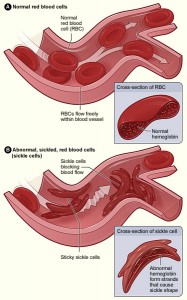September is National Sicle Cell month, and it is one of those diseases that people tend to know a little bit about but don’t really understand the full extend of the disease, who usually has the disease, and what the implications are. And after a few questions from readers, I figured, why not highlight it and give some insight.
Sickle cell is a trait with the red blood cells due to a gene mutation in the hemoglobin, the red blood cells, instead of being circular, are in an abnormal and rigid “sickled” shape. It is an autosomal recessive genetic blood disorder, which causes the cells to become rigid and can cause tons of complications, especially when a person goes into “crisis”. So it is present at birth, as it is a genetic mutation, but most people aren’t diagnosed until after 4 months of age, and it does decease your life expectancy to around 50-ish years of age for both men and women.
Who is at Risk?
Sickle cell is actually a genetic mutation that the body created to prevent malaria infections. Thus, people from tropical and subtropical areas where malaria is a high risk, also those whose family/heritage is from that area can also have the genetic anomaly. Approximately 1/3rd of all people in Sub Saharan Africa are affected by sickle cell, and 1 in 500 African-American children born in the US will also carry this trait. If you have sickle cell, and are infected with malaria, due to the shape of the cells, the malaria infection is not as significant as the malaria parasite lives a part of its life in the red blood cells, so you can live longer with malaria and not face as many of the side effects.
What are the Symptoms/Side Effects?
As I mentioned above, there is such a thing as sickle cell crisis, and honestly it can be one of a few reactions, usually brought on by stress or exposure to the cold, and the crises last for about 5-7 days and cause extreme pain, leading to frequent hospital stays for treatment.
–Vaso-occlusive crisis: When the sickle shaped cells obstruct blood flow in the capillaries (the very small blood vessels that come off of larger vessels), which causes swelling, pain, and can cause cellular death leading to death of the skin in the area from lack of blood flow. This can happen anywhere in the body, but men beware, this can happen in the penis causing priapism which is a medical emergency (it needs to be treated so you don’t have tissue death in your penis).
–Splenic sequestration crisis: The spleen is the organ where it basically filters out old blood cells and is a storage for red cells. Thus, you can see that it would be a high risk organ to be affected by the sickle cells. It is an acute enlargement of the spleen, which is very painful and causes a rigid abdomen, it is also a medical emergency and most often a splenectomy is required to treat the problem. This usually happens to children with sickle cell, and they are then required to take preventative medications to stave off infections and have a very strict vaccination regimen.
–Aplastic anemia/Heamolytic crisis: A worsening of the baseline anemia that patients with sickle cell have. anemia is having low hemoglobin levels (or low blood levels). The patient will most often have trouble breathing (low blood levels means less hemoglobin for oxygen to bind to so you need to put more work into breathing to get enough oxygen to your organs), also the are very pale, and they have very low energy. This crisis may require a blood transfusion for treatment.
Due to these various crises, there are long-term complications that can occur, such as: chronic pain, leading to opiate addiction, renal failure insufficiency (clotting in the renal tubules), stroke, transischemic attacks (TIA’s: like a mini stroke with resolving symptoms but can cause long-term brain damage), mini clots in the vessels leading to the eyes causing blindness, pulmonary hypertension which can put undue stress on the heart and lead to heart failure. There are many other complications as well.
Are treatments available? Prevention?
Really all the treatments are supportive treatments to make the patient comfortable while having the pain and until the crisis is over. Nothing will make sickle cell go away, it is a genetic mutation that you have for life. And because it is a genetic disease, you can not prevent it BUT if you are at risk as a carrier, you can get genetic testing for you and your partner, to find out what the risk would be for your offspring. It truly can be a devastating disease, very painful, with frequent trips to the hospital and long stays. Learning to live with the disease and what your particular triggers are (working with your HCP) will help to make managing the disease easier and lead to fewer complications.
Yours in Good Health
B


